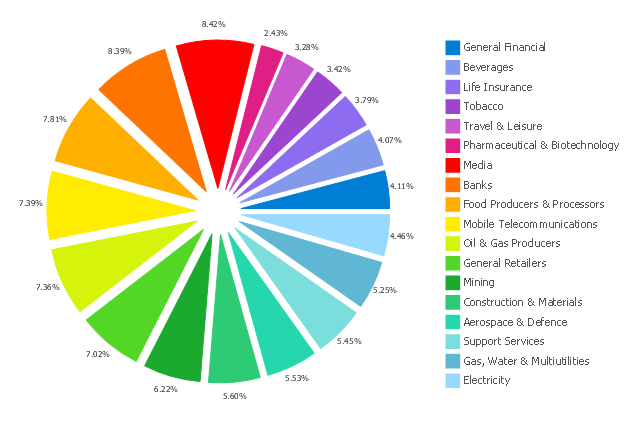This exploded pie chart sample shows the economic sector weightings. It was designed on the base of the Wikimedia Commons file: Badpie.png [commons.wikimedia.org/ wiki/ File:Badpie.png].
This image is available under the Creative Commons Attribution-ShareAlike 3.0 Unported License [creativecommons.org/ licenses/ by-sa/ 3.0/ ].
"The classical breakdown of all economic sectors follows:
Primary: Involves the retrieval and production of raw materials, such as corn, coal, wood and iron. (A coal miner and a fisherman would be workers in the primary sector.)
Secondary: Involves the transformation of raw or intermediate materials into goods e.g. manufacturing steel into cars, or textiles into clothing. (A builder and a dressmaker would be workers in the secondary sector.)
Tertiary: Involves the supplying of services to consumers and businesses, such as baby-sitting, cinema and banking. (A shopkeeper and an accountant would be workers in the tertiary sector.)
In the 20th century, it began to be argued that traditional tertiary services could be further distinguished from "quaternary" and quinary service sectors." [Economic sector. Wikipedia]
The exploded pie chart example "Economic sector weightings" was created using the ConceptDraw PRO diagramming and vector drawing software extended with the Pie Charts solution of the Graphs and Charts area in ConceptDraw Solution Park.
This image is available under the Creative Commons Attribution-ShareAlike 3.0 Unported License [creativecommons.org/ licenses/ by-sa/ 3.0/ ].
"The classical breakdown of all economic sectors follows:
Primary: Involves the retrieval and production of raw materials, such as corn, coal, wood and iron. (A coal miner and a fisherman would be workers in the primary sector.)
Secondary: Involves the transformation of raw or intermediate materials into goods e.g. manufacturing steel into cars, or textiles into clothing. (A builder and a dressmaker would be workers in the secondary sector.)
Tertiary: Involves the supplying of services to consumers and businesses, such as baby-sitting, cinema and banking. (A shopkeeper and an accountant would be workers in the tertiary sector.)
In the 20th century, it began to be argued that traditional tertiary services could be further distinguished from "quaternary" and quinary service sectors." [Economic sector. Wikipedia]
The exploded pie chart example "Economic sector weightings" was created using the ConceptDraw PRO diagramming and vector drawing software extended with the Pie Charts solution of the Graphs and Charts area in ConceptDraw Solution Park.
 Stakeholder Onion Diagrams
Stakeholder Onion Diagrams
The Stakeholder Onion Diagram is often used as a way to view the relationships of stakeholders to a project goal. A basic Onion Diagram contains a rich information. It shows significance of stakeholders that will have has influence to the success achieve
- Draw A Flow Chart To Show The Primary Sector Of Any Good The
- Economic sector weightings | Room Planning Software | Porter's ...
- Flow Chart Of The Primary Sector Secondary Sector And Tertiary
- Primary Sector Image Drawing
- A Diagram Of Primary Sector
- Diagram Of Primary Secondary And Tertiary Sectors
- Draw Are Pictures That Represents Primary Sector Secondary ...
- Primary Secondary Tertiary Sectors Flow Diagrams Example
- Divided Bar Diagrams | Pictures For Primary Sector For Drawing
- Flow Chart Of Clothing Including Primary Sector Secondary Sector ...
- Flow Diagram Showing The Process From Primary Through To
- Primary Secondary And Tertiary Sectors Of Clothing In Diagrams
- Sector diagram - Template | Economic sector weightings | New ...
- Primary Sector Secondary Sector And Tertiary Sector Flow Diagram
- Flowchart Of Primary Sector
- Primary Sector Diagram
- Draw Or Design A Picture That Represents A Products Of Primary ...
- Economic sector weightings | Divided Bar Diagrams | Stakeholder ...
- Draw A Picture That Represents A Product Of Primary Secondary ...
- A Flow Diagram Of Primary Sector
